Lovecraft’s Dreamlands Via Graphic Novel: Jason Thompson’s The Dream-Quest of the Unknown Kadath & Other Stories
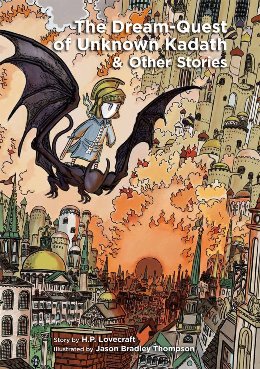
Jason Thompson sent me a copy of his The Dream-Quest of the Unknown Kadath & Other Stories. It even came in a cool envelope, but I’ll get to that.
I’ve been on a bit of a Lovecraft quest.
HP Lovecraft is more than a Geek-only in-joke, there’s still something powerful about his works — or so I discovered reading “The Festival,” “Shadow over Innsmouth” and “Whisperer in the Dark” to my 8-year-old daughter. She experienced the stories as like Scoobie Doo, but when you pull off the bad guy’s mask his face is made of worms.
So, though the style is dated and thus heavy going in places, the structure is sound: he really nailed the whole “unfolding mystery leading to horrible revelation” trope. (I must therefore take back what I said before, I’m sure people do read HP Lovecraft for pleasure from time to time, much as we might also read Malory, because I am now one of them.)
Lovecraft’s power goes way beyond spinning a spooky yarn. He has a knack of being intriguingly vague with great certainty.
The intriguingly is the important part that people often miss.
As frustrated teenage writers discover, vague descriptions of random stuff you made up are not in themselves intriguing. What makes Lovecraft intriguing as well as certain is that he is referencing what feels like a fully realised and disquieting story world, his famous Cthulhu Mythos.
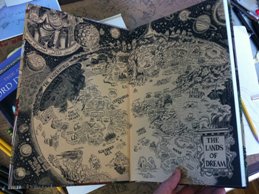
The Cthulhu Mythos is like the Harry Potter world of magicians that hides behind the mundane world of us “muggles”.
Just as we love JK Rowling’s stories, but we also yearn to hear more about the Ministry of Magic, the Knight Bus and Quidditch, and demand more history and legend, we enjoy Lovecraft’s yarns but crave more forbidden knowledge about the Fungi from Yuggoth who infest the stars, the City of R’lyeh where Cthulhu sleeps, and the Deep Ones living out their parallel lives in decaying fishing ports. That the we are at best cookies to the alien monsters lends a dark thrill to the exploration. Each story gives us a glimpse not just of the existential horror behind our reality, but of its living structure.
Which leads me to Lovecraft’s Dreamlands stories in which he turns Dante and visits one corner of his Mythos in great detail.
The Dreamlands are a material astral plain or fairy land which human dreamers can shape but also must mingle with very real and dangerous denizens — essentially Second Life but where the scammers can eat your soul.
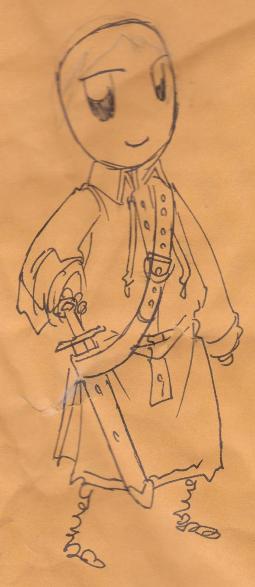
This is a lushly dark secondary world, but Lovecraft at his most descriptive is also Lovecraft at his least readable: these days processions of big long words are more alienating than evocative! Since Lovecraft was painting pictures with words, wouldn’t it be better just to provide pictures?
And so we have the various graphic novel versions of these stories.
The snag is that the artist or writer must replace the effect of being intriguingly vague with something else as powerful. In his graphic novel Kadath — which I’ve already reviewed — Charles Cutting turns Randolph Carter, the protagonist, into the real object of horror: the loud spoken Imperialist tourist who destroys what he touches. It’s a powerful re-reading of the tale, colorfully illustrated.
Jason Thompson, however, in his crowd funded The Dream-Quest of the Unknown Kadath & Other Stories takes a different track.
He copes with the challenge partly by “going up to 11” with the artwork, but also by using his art to inject, or bring out, the pathos of the dreamers themselves. Otherwise, apart from the odd tweak for story logic, he sticks to the text of the original stories, reusing snippets it in his narrative panels.
The artwork is amazing!
The setting has an Orientalist feel but an alien one. Thompson doesn’t directly lift from our own world, which has the benefit of avoiding cultural appropriation and imperialism — Orientalism was always a western projection anyway, so why not start with a blank canvas? The monsters are… well monstrous, and the alien denizens have a subtle nightmare quality about them. This may not be what Lovecraft saw in his mind’s eye, but since it draws on early 20th century visual tropes, it feels like it could be.
There’s more than a visual feast. There’s the pathos generated by Thompson’s “Mockman,” the childlike avatar he uses to represent the dreamer protagonist in each of his stories.
I said the book arrived in a cool envelope. He’d drawn one of these figures on it!
When I quizzed him about it, he explained that the figure began long ago as an easy-to-draw protagonist he could consistently reproduce from panel to panel, but ended up having a deeper significance.
The Mockman paradoxically reminds us that this is a dream while at the same time to heightening the peril. He never really feels like an adult, but rather a child being “super serious” and pretending to be grown up while facing grownup perils, like the kids in Stranger Things solemnly selecting stones for a slingshot with which they expect to take on what we know is a lethal [SPOILER REDACTED]. This quietly and uncomfortably takes us into Transactional Analysis territory, with our Inner (simplification!) Child sometimes shouldering responsibilities it would be be best handing off to our Adult or Parent.
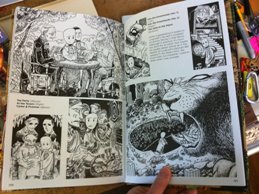
It’s the pathos, though, that really justifies the Mockman.
The Mockman is the ageless child who quests but lives in the now. The Dreamer, though, is not ageless and has a life history and expectancy.
This comes across most obviously in “Celaphais” and its follow-ip sequence in “Kadath.” (Spoilers!)
Kuranes is born into the decaying aristocracy of our world, becomes sucked up by the alienating big city. But all his life he dreams of the awesome city of Celephais. The dream world is so much better than the reality that he spends more and more time there, meanwhile sinking lower and lower in the real world. Aged homeless and drug addled, he meets his end near his ancestral home, but a cortege from the Dreamlands fetches his soul home to rule in Celaphais, and the soul of course is an ageless childlike Mockman.
This strikes so many chords!
It’s the tragic Geek life experience.
I once had a tech job so bleakly meaningless that I couldn’t bear to listen to music while doing it. Rather than lift my spirits, the Gladiator soundtrack just reminded me of where I was not!
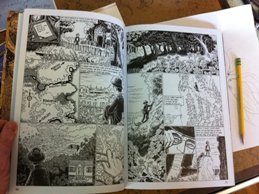
I don’t think that’s unusual. The office rarely measures up to Friday night playing D&D, or evenings gaming online or watching genre TV, or rainy weekends tucked up with a good book, or glorious long weekends at conventions.
Most of us would rather be with our friends — real or imaginary — in the Dreamlands than at the keyboard with our colleagues.
It’s also the human experience!
As a friend of mine put it: inside every old person is an 8-year-old going, “WTF went wrong here?”
And perhaps that’s the true horror that underlies this excellent graphic novel rendering of HP Lovecraft’s Dreamland stories. Compared to that, the gods and monsters are a welcome distraction…
(Is this book suitable for children? I’d confidently give it to any Mythos fan over 12. The artwork is beautiful just to flick through, but depicts horrors that Lovecraft only evoked, with cannibalism, dismembered body parts and a dungeon with dead torture victims… no worse than the Horrible Histories, I guess. The narrative panels are direct quotes from the Lovecraft original, suitable for a literate 10-year-old perhaps, but only if they’re hooked on the world. Thompson depicts ethnicity, not all of it earthly, but avoids racist stereotypes. He doesn’t try to “improve” Lovecraft, so slavery is taken for granted — as per many fantasy and historical stories — and there is a reference to “black slaves” being shipped off to an uncertain fate, which you may find problematic or at least worth a conversation. There are drugs references. You might also want to talk about those too.)
You can buy H.P. Lovecraft’s The Dream-Quest of Unknown Kadath and Other Stories direct from the artist’s website or from Amazon.
M Harold Page is the Scottish author of works such as Swords vs Tanks (Charles Stross: “Holy ****!”). For his take on writing, read Storyteller Tools: Outline from vision to finished novel without losing the magic. (Ken MacLeod: “…very useful in getting from ideas etc to plot and story.” Hannu Rajaniemi: “…find myself to coming back to [this] book in the early stages.”)